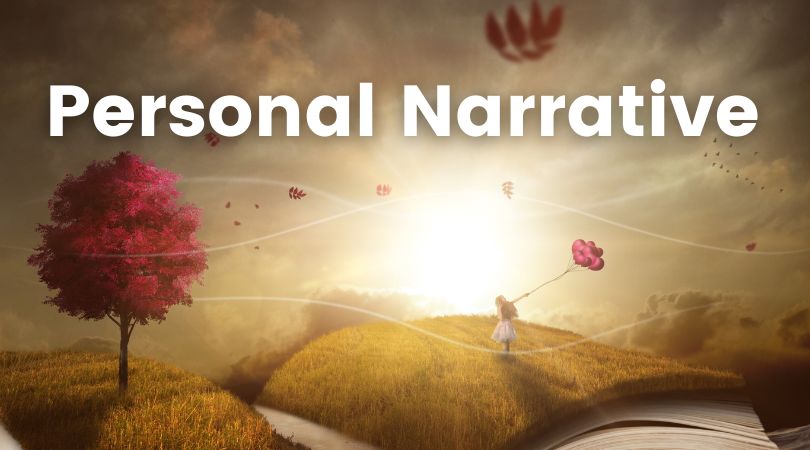Personal narratives are the heartbeat of storytelling. Whether through the pages of our favorite novels, the silver screen of our theaters, or the quiet blogs we scroll through on our devices, personal narratives have the unique power to captivate hearts.
For content creators, bloggers, and writers, understanding and harnessing the essence of personal narratives can transform a mere collection of words into an emotional, thought-provoking, and influential story.
In this extensive guide, we’ll dive deep into what makes a personal narrative unique, why it’s critical to modern content creation, and how you can craft narratives that resonate with your audience.
We’ll explore the very DNA of personal narratives – their structure, components, and the emotional and psychological impact they can have on readers.
By the end of this post, you’ll not only understand what a personal narrative is, but you’ll be equipped to infuse your work with this powerful storytelling technique.
Understanding Personal Narratives
As humans, we are wired to connect with others through shared experiences and emotions.
By sharing our personal narrative, we open ourselves up to vulnerability and create a connection with our audience.
To better understand this concept, let’s explore the personal narrative definition.
What is a Personal Narrative?

At its core, a personal narrative is a story that recounts an experience from the author’s life.
It can be a significant event, a life-changing decision, an entire life story, or even just an ordinary day.
What sets personal narratives apart from other forms of storytelling is the personal perspective and emotion infused into every word.
It allows the reader to step into the shoes of the writer and experience their story firsthand.
A well-crafted personal narrative evokes empathy, sympathy, and understanding from the audience.
A good personal narrative isn’t about just recounting events. It’s a means of understanding and communicating one’s own perspective and connection to the world.
Why is Storytelling Important for Content Creation?
Storytelling is ingrained in human nature. It’s how we’ve communicated experiences, passed down wisdom, and connected with each other throughout history.
Even in today’s fast-paced digital world, content creators are constantly looking for ways to stand out, connect, and engage with their audience.
With the rise of social media and blogging, storytelling has become a powerful tool in the content creation arsenal.
Our personal stories and experiences are what create a deeper connection with our audience and set ourselves apart from the sea of generic content.
A personal narrative is a way to tap into the emotional and psychological impact of storytelling and create a lasting connection with our readers.
How Does a Narrative Differ From Traditional Storytelling?
While both narratives and traditional stories have a beginning, middle, and end, the central focus of a narrative is the personal growth and experiences that drive this journey.
Traditional storytelling typically follows a character’s external journey, while personal narratives focus on their internal transformation.
In a personal narrative, the writer takes on the role of both storyteller and subject.
They are not just recounting events but sharing their unique perspective and emotions throughout the journey.
This intimate connection between the writer and reader is what sets a personal story or narrative apart from traditional storytelling.
The About Me Page: A Compelling Narrative
One of the most popular platforms for personal narratives is the “About Me” page on websites and blogs.

This page serves as an introduction to the writer or blogger, but also gives readers a glimpse into who they are as a person.
A well-crafted About Me page will not only list facts and accomplishments but will tell a story about the writer’s journey and what drives them.
It’s an opportunity to for the author of the blog to start connecting with their audience and show that there is a real person behind the writing.
Components of a Personal Narrative
Now that we have a better understanding of what a personal narrative is, let’s dive deeper into the key components of a good personal narrative.
The Protagonist: Who is the Main Character?
The protagonist of a personal narrative is the author themselves.
They are the one experiencing the events and sharing their unique perspective with the audience.
They are the focal point, and the story revolves around their thoughts, emotions, and actions.
It’s crucial for the writer to be honest, vulnerable, and authentic in portraying themselves as the protagonist.
The Setting: Where Does the Story Take Place?
The setting of a personal narrative can be as specific or general as the writer chooses.
It can be a location, such as a city, town, or even an entire country.
It can also refer to a time period, such as childhood, teenage years, or adulthood.
The setting helps ground the audience in the story and provides context for the events that occur.
The Conflict: What Challenges Does the Protagonist Face?
Every good story needs conflict, and personal narrative writing is no exception.
This conflict can come from external sources, such as other people, current or past events, or internal struggles within the protagonist.
This conflict is what drives the narrative forward and allows for growth and transformation to occur.
The Resolution: How is the Conflict Resolved?
A personal narrative is not complete without a resolution.
This is where the protagonist faces their challenges and either overcomes them or learns to live with them.
The resolution can bring closure, insight, and transformation for both the writer and the audience.
It also doesn’t always have a neat and tidy resolution. Sometimes the ‘resolution’ is in the form of learning to live with the consequences.
The key is to show the reader the path from the beginning to an end, whether it’s a complete resolution or an acceptance of a new status quo.
The Reflection: What Lessons or Insights Are Gained?
Reflection is an essential element of a personal narrative.
It allows the writer to step back and examine their journey, share insights, and communicate the lessons they’ve learned along the way.
This not only adds depth and meaning to the story but also allows for a deeper connection between the writer and reader.
The Power of Personal Narratives
A personal narrative has the power to evoke emotions, inspire change, and create a lasting connection with our audience.
Emotional Connection with the Audience
Sharing our emotional experiences requires vulnerability and this openness with your audience is what creates emotional connections.
People don’t want perfectly polished examples of what to do.
They want real and raw experiences that they can learn from. They want someone who they can relate to.
Building Trust and Authenticity
Being vulnerable requires courage, especially when you’re sharing negative experiences and consequences with the world.
Being your authentic self, even when it’s hard, is what helps you build trust with your audience.
Authenticity is also what makes you stand out from the others. No one has walked in your shoes but you.
No one can replicate your own story and your own writing.
Inspiring Change and Empathy
A personal narrative has the power to move people to action.
The more relatable you are and the stronger the connection your audience has with you, the more you can inspire them to change.
The more they will feel that it’s possible to make a positive change because you successfully did it.
Your personal narrative can also evoke empathy in your readers, helping them see things from a different perspective and understand the human experience better.
5 Tips for Crafting Compelling Personal Narratives
Here are five writing tips to keep in mind when crafting your personal narrative.
1. Identifying the Purpose and Target Audience
Before even starting to write a personal narrative, it’s crucial to identify the purpose behind it and who your target audience is.
- Is it meant to inspire, educate, or entertain?
- Who are you hoping will read your story?
Knowing this will help you tailor your writing and ensure that you’re delivering the right message to the right people.
If you’re a blogger or content creator, try looking into the analytics on your search or social platforms see more information about the demographics of your audience.

2. Choosing the Right Story and Angle
Not every personal experience is a great narrative.
Choose stories that are significant, embody a clear transformation, and can provide a substantial takeaway for the reader.
The angle from which you tell the story can also drastically change its impact, so consider which angle best serves your narrative’s purpose.
3. Engaging Storytelling Techniques
As a personal narrative is essentially a story, it’s essential to use engaging storytelling techniques.
- Use descriptive language and imagery to paint a vivid picture for your audience.
- Incorporate dialogue and sensory details to bring the reader into the moment.
- Vary sentence structure and length to create rhythm and flow in your writing.
- The tone of your narrative should align with the emotions of your story, whether it is light-hearted, somber, suspenseful, or reflective, to fully immerse the reader in your experience.
4. Consider Various Literary Techniques
Literary techniques can add depth and impact to your personal narrative.
Some examples include:
- Foreshadowing to build suspense and hint at upcoming events.
- Symbolism to convey deeper meaning and themes.
- Irony to add an unexpected twist or reveal.
- Colloquialisms and slang to add authenticity and convey character
5. Balancing Personal and Universal Elements
While a personal narrative is about your experience, it should also have universal elements that make it relatable to a broader audience.
We all share similar emotions and experiences as human beings so finding those universal threads can be key to engaging a wider readership.
FAQs About Personal Narratives
Key Takeaways for Writing a Personal Narrative
Personal narratives are not just stories; they are experiences shared, lessons learned, and emotions felt.
They are the essence of human connection in the vast world of content sharing.
By understanding personal narratives and the power they hold, you can take your content creation to another level.
Here is a quick summary of how to write personal narratives that are both engaging and compelling:
- Start with a compelling hook that draws the reader in.
- Develop vivid characters and setting to immerse readers in your story.
- Include a central conflict that creates tension and leads to reflection or growth.
- Reflect on the broader theme or message of your narrative.
- Find universal elements to make your story relatable to a wider audience.
- Use descriptive language and sensory details to bring your story to life.
- Structure your plot with a clear beginning, middle, and end.
- Use a first-person perspective to provide a personal touch.
- Be honest, vulnerable, and introspective in your narration.
- End with a resolution or reflection that brings closure to the story and leaves an impact on the reader.